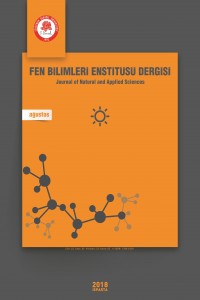Engineering Characteristics of Geopolymer Mortars Manufactured with Ground Granulated Blast Furnace Slag
Abstract
Geopolymers are obtained by various methods in different alkaline environments by changing compositions and crystal structures of pozzolans, which have Al and Si oxide compounds in their structures and carry little or no hydraulic characteristics. In this study, mechanical and physical characteristics of geopolymer mortars manufactured with ground granulated blast furnace slag (GGBFS) and activated with sodium silicate (water glass) were determined and also their SEM-EDS analyses were performed. As a result of the study, it was determined that geopolymers prepared with GGBFS can also be used in the areas where blast furnace slag cement would be used.
References
- [1] Aleem, M. I. A., Arumairaj, P. D. 2012. Geopolymer Concrete-A Revıew. International Journal of Engineering Sciences & Emerging Technologies. 1(2), 118-22.
- [2] Köleli, Y. 2015. TR63 Bölgesi Çimento Sektör Raporu. Doğu Akdeniz Kalkınma Ajansı: Doğu Akdeniz Kalkınma Ajansı.
- [3] Tokyay, M., Erdoğdu, K. 2009. Cüruflar ve Cüruflu Çimentolar. TÇMB / AR-GE / Y 972. Ankara: TÇMB.
- [4] Baradan, B., Yazıcı, H., Aydın, S. 2012. Beton. İzmir: Dokuz Eylül Üniversitesi Mühendislik Fakültesi Yayınları.
- [5] Dorum, A., Koçak, Y., Yılmaz, B., Uçar, A. 2009. The Effects of Blast Furnace Slag on the Cement Surface Properties and Hydration. Journal of the Institute of Science and Technology of Dumlupinar University. 19, 47-58.
- [6] El-Didamony, H., Amer, A. A., El-Sokkary, T. M., Abd-El-Aziz, H. 2013. Effect of substitution of granulated slag by air-cooled slag on the properties of alkali activated slag. Ceramics International. 39(1), 171-81.
- [7] Praveen, J. A., Senthilkumar, P., Sridhar, J., Nickson, S. 2015. A Comparative Study of Alkali Activated Slag and Fly Ash-Based Geopolymer Concrete. International Journal of Innovative Research in Science, Engineering and Technology. 2001, 10151-10156.
- [8] Universit, B., Benbouali, H. 2009. Some Parameters Affecting the Heat of Hydration of Blast-Furnace Slag. SBEIDCO – 1st International Conference on Sustainable Built Environment Infrastructures in Developing Countries ENSET. (Durability of materials and structures), 8-16.
- [9] Davidovits, J. 1991. Geopolymers: Inorganic Polymeric New Materials. Journal of Thermal Analysis. 37, 1633-1656.
- [10] Xu, H., Van Deventer, J. S. J. 2000. The geopolymerisation of alumino-silicate minerals. International Journal of Mineral Processing. 59(3), 247-266.
- [11] Görhan, G., Kürklü, G. 2014. Alkali Tuz İçeriğinin Geopolimer Cephe Kaplama Malzemesi Özelliklerine Etkisi. 7 Ulusal Çatı & Cephe Sempozyumu. İstanbul, 51-58.
- [12] Altan, E., Erdogan, S. T. 2012. Alkali activation of a slag at ambient and elevated temperatures. Cement Concrete Comp., 34(2), 131-139.
- [13] Chi, M. 2012. Effects of dosage of alkali-activated solution and curing conditions on the properties and durability of alkali-activated slag concrete. Construction and Building Materials. 35, 240-245.
- [14] Dutta, D., Ghosh, S. 2014. Durability Study of Geopolymer Paste Blended with Blast Furnace Slag. IOSR Journal of Mechanical and Civil Engineering, 11(2), 73-79.
- [15] Madheswaran, C. K., Gnanasundar, G, Gopalakrishnan, N. 2013. Effect of molarity in geopolymer concrete. International Journal of Civil and Structural Engineering, 4(2), 106-115.
- [16] Krishnan, L., Karthikeyan, S., Nathiya, S., Suganya, K. 2014. Geopolymer Concrete an Eco-Friendly Construction Material. IJRET: International Journal of Research in Engineering and Technology, 2319-2322.
- [17] Ramani, P. V., Chinnaraj, P. K. 2015. Geopolymer concrete with ground granulated blast furnace slag and black rice husk ash. GRAĐEVINAR, 67, 741-748.
- [18] Mathew, B. J., Sudhakar, M., Natarajan, C., Ash, B. 2013. Strength, Economic and Sustainability Characteristics of Coal Ash – GGBS Based Geopolymer Concrete. International Journal of Computational Engineering Research, 3, 207-212.
- [19] Bakharev, T., Gnananandan, J., Cheng, Y. B. 1999. Alkali activation of Australian slag cements. Cement and Concrete Research, 29, 113-120.
- [20] Allahverdi, A. L. I., Kani, E. N., Yazdanipour, M. 2011 Effects of Blast-Furnace Slag on Natural Pozzolan-Based Geopolymer Cement. Ceramics – Silikáty, 55(1), 68-78.
- [21] Angulo-ramírez, D. E., Mejía, R., Gutiérrez, D., Puertas, F. 2017. Alkali-activated Portland blast-furnace slag cement : Mechanical properties and hydration. Construction and Building Materials, 140, 119-28.
- [22] TS EN 15167-1. 2006. Ground granulated blast furnace slag for use in concrete, mortar and grout - Part 1: Definitions, specifications and conformity criteria. Turkish Standards Instituion, 23.
- [23] TS EN 197-1. 2012. Cement - Part 1: Composition, specifications and conformity criteria for common cements: Turkish Standards Instituion, 2012.
- [24] TS EN 196-1. 2016. Methods of testing cement - Part 1: Determination of strength. Turkish Standards Instituion, 35.
- [25] TS EN 1015-3/A2. 2007. Methods of test for mortar for masonry - Part 3: Determination of consistence of fresh mortar (by flow table) Turkish Standards Instituion, 5.
- [26] TS EN 12350-6. 2010. Testing fresh concrete - Part 6: Density Turkish Standards Instituion, 12.
- [27] TS EN 12390-7. 2010. Testing hardened concrete - Part 7: Density of hardened concrete. Turkish Standards Instituion, 11.
- [28] ASTM C 642-13. 2013. Standard Test Method for Density, Absorption, and Voids in Hardened Concrete. West Conshohocken, PA,: ASTM International.
- [29] Uygunoğlu, T. 2008. Properties of Self-Compacting Concrete with Lightweight Aggregate. Isparta: Süleyman Demirel University.
- [30] ASTM C1585 - 04. 2004. Measurement of Rate of Absorption of Water by Hydraulic- Cement Concretes. West Conshohocken, PA,: ASTM International, 6.
- [31] Newman, J., Choo, B. S. 2003. Advanced Concrete Technology 1: Constituent Materials: Elsevier Science.
Details
| Journal Section | Articles |
|---|---|
| Authors | |
| Publication Date | August 15, 2018 |
| Published in Issue | Year 2018 Volume: 22 Issue: 2 |
Cite
e-ISSN :1308-6529
Linking ISSN (ISSN-L): 1300-7688
All published articles in the journal can be accessed free of charge and are open access under the Creative Commons CC BY-NC (Attribution-NonCommercial) license. All authors and other journal users are deemed to have accepted this situation. Click here to access detailed information about the CC BY-NC license.

